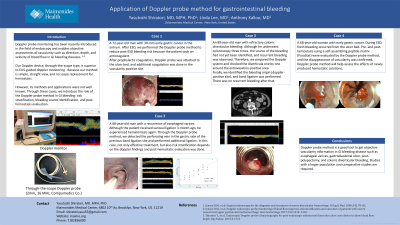Tuesday Poster Session
Category: Endoscopy Video Forum
P3225 - Application of Doppler Probe Method for Gastrointestinal Bleeding
Tuesday, October 24, 2023
10:30 AM - 4:00 PM PT
Location: Exhibit Hall

Has Audio

Yasutoshi Shiratori, MD, MPH, PhD
Maimonides Medical Center
Brooklyn, NY
Presenting Author(s)
Yasutoshi Shiratori, MD, MPH, PhD, Linda Lee, MD, MBA, Anthony Kalloo, MD, FACG
Maimonides Medical Center, Brooklyn, NY
Introduction: Doppler probe monitoring has been recently introduced in the field of endoscopy and enables objective assessments of vascularity in gastrointestinal bleeding diseases. However, its methods and applications were not well known. In this video, we demonstrate the role of the Doppler probe method in gastrointestinal bleeding: risk stratification, bleeding source identification, and post-hemostasis evaluation.
Case Description/Methods: Case 1: A 72-year-old man with 30-mm early gastric cancer in the antrum. After endoscopic submucosal dissection (ESD), we performed the Doppler probe method to reduce post-ESD bleeding risk because the patient took an anticoagulant. After prophylactic coagulation, Doppler probe was attached to the ulcer bed, and additional coagulation was done in the vascularity-positive site.
Case 2: A 68-year-old man with a recurrence of esophageal varices. Although the patient received variceal ligation 3-month ago, he experienced hematemesis again. Through the Doppler probe method, we detected the perforating vein in the anal side of the band ligation scar and performed additional ligation effectively. In this case, post-hemostatic evaluation was also done.
Case 3: An 89-year-old man with refractory colonic diverticular bleeding. Although he underwent colonoscopy three times, the source of the bleeding had not yet been identified, and recurrent bleeding was observed. Therefore, we prepared the Doppler system and checked the diverticula one by one around the extravasation-positive area. Ultimately, we identified the bleeding origin, and band ligation was performed. There was no recurrent bleeding after that.
Case 4: A 68-year-old woman with early gastric cancer. During ESD, fresh bleeding occurred from the ulcer bed. Pre and post-hemostasis using a self-assembling peptide matrix (PuraStat) were evaluated by the Doppler probe method, and the disappearance of vascularity was confirmed. Through this case, the hemostatic effects of PureStat were assessed objectively, and this finding will support further use of PuraStat in the hemostatic field. Like this case, the Doppler probe method will help assess the effects of newly produced hemostatic solutions effects.
Discussion: Doppler probe method is a good tool to get objective vascularity information in gastrointestinal bleeding diseases. Studies with a larger population and comparative studies are required.
Disclosures:
Yasutoshi Shiratori, MD, MPH, PhD, Linda Lee, MD, MBA, Anthony Kalloo, MD, FACG. P3225 - Application of Doppler Probe Method for Gastrointestinal Bleeding, ACG 2023 Annual Scientific Meeting Abstracts. Vancouver, BC, Canada: American College of Gastroenterology.
Maimonides Medical Center, Brooklyn, NY
Introduction: Doppler probe monitoring has been recently introduced in the field of endoscopy and enables objective assessments of vascularity in gastrointestinal bleeding diseases. However, its methods and applications were not well known. In this video, we demonstrate the role of the Doppler probe method in gastrointestinal bleeding: risk stratification, bleeding source identification, and post-hemostasis evaluation.
Case Description/Methods: Case 1: A 72-year-old man with 30-mm early gastric cancer in the antrum. After endoscopic submucosal dissection (ESD), we performed the Doppler probe method to reduce post-ESD bleeding risk because the patient took an anticoagulant. After prophylactic coagulation, Doppler probe was attached to the ulcer bed, and additional coagulation was done in the vascularity-positive site.
Case 2: A 68-year-old man with a recurrence of esophageal varices. Although the patient received variceal ligation 3-month ago, he experienced hematemesis again. Through the Doppler probe method, we detected the perforating vein in the anal side of the band ligation scar and performed additional ligation effectively. In this case, post-hemostatic evaluation was also done.
Case 3: An 89-year-old man with refractory colonic diverticular bleeding. Although he underwent colonoscopy three times, the source of the bleeding had not yet been identified, and recurrent bleeding was observed. Therefore, we prepared the Doppler system and checked the diverticula one by one around the extravasation-positive area. Ultimately, we identified the bleeding origin, and band ligation was performed. There was no recurrent bleeding after that.
Case 4: A 68-year-old woman with early gastric cancer. During ESD, fresh bleeding occurred from the ulcer bed. Pre and post-hemostasis using a self-assembling peptide matrix (PuraStat) were evaluated by the Doppler probe method, and the disappearance of vascularity was confirmed. Through this case, the hemostatic effects of PureStat were assessed objectively, and this finding will support further use of PuraStat in the hemostatic field. Like this case, the Doppler probe method will help assess the effects of newly produced hemostatic solutions effects.
Discussion: Doppler probe method is a good tool to get objective vascularity information in gastrointestinal bleeding diseases. Studies with a larger population and comparative studies are required.
Disclosures:
Yasutoshi Shiratori indicated no relevant financial relationships.
Linda Lee indicated no relevant financial relationships.
Anthony Kalloo indicated no relevant financial relationships.
Yasutoshi Shiratori, MD, MPH, PhD, Linda Lee, MD, MBA, Anthony Kalloo, MD, FACG. P3225 - Application of Doppler Probe Method for Gastrointestinal Bleeding, ACG 2023 Annual Scientific Meeting Abstracts. Vancouver, BC, Canada: American College of Gastroenterology.
